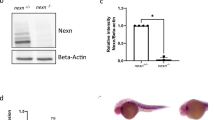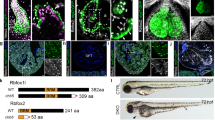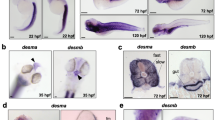Abstract
The zebrafish embryo is transparent and can tolerate absence of blood flow because its oxygen is delivered by diffusion rather than by the cardiovascular system1. It is therefore possible to attribute cardiac failure directly to particular genes by ruling out the possibility that it is due to a secondary effect of hypoxia. We focus here on pickwickm171 (pikm171), a recessive lethal mutation discovered in a large-scale genetic screen2. There are three other alleles in the pik complementation group with this phenotype (pikm242, pikm740, pikm186; ref. 3) and one allele (pikmVO62H) with additional skeletal paralysis4. The pik heart develops normally but is poorly contractile from the first beat. Aside from the edema that inevitably accompanies cardiac dysfunction, development is normal during the first three days. We show by positional cloning that the 'causative' mutation is in an alternatively-spliced exon of the gene (ttn) encoding Titin. Titin is the biggest known protein and spans the half-sarcomere from Z-disc to M-line in heart and skeletal muscle5. It has been proposed to provide a scaffold for the assembly of thick and thin filaments6 and to provide elastic recoil engendered by stretch during diastole7. We found that nascent myofibrils form in pik mutants, but normal sarcomeres are absent. Mutant cells transplanted to wildtype hearts remain thin and bulge outwards as individual cell aneurysms without affecting nearby wildtype cardiomyocytes, indicating that the contractile deficiency is cell-autonomous. Absence of Titin function thus results in blockage of sarcomere assembly and causes a functional disorder resembling human dilated cardiomyopathies, one form of which is described in another paper in this issue8.
This is a preview of subscription content, access via your institution
Access options
Subscribe to this journal
Receive 12 print issues and online access
$209.00 per year
only $17.42 per issue
Buy this article
- Purchase on Springer Link
- Instant access to full article PDF
Prices may be subject to local taxes which are calculated during checkout




Similar content being viewed by others
References
Burggren, W.W. & Pinder, A.W. Ontogeny of cardiovascular and respiratory physiology in lower vertebrates. Annu. Rev. Physiol. 53, 107–135 (1991).
Driever, W. et al. A genetic screen for mutations affecting embryogenesis in zebrafish. Development 123, 37–46 (1996).
Stainier, D.Y. et al. Mutations affecting the formation and function of the cardiovascular system in the zebrafish embryo. Development 123, 285–292 (1996).
Warren, K.S., Wu, J.C., Pinet, F. & Fishman, M.C. The genetic basis of cardiac function: dissection by zebrafish (Danio rerio) screens. Philos. Trans. R. Soc. Lond. B Biol. Sci. 355, 939–944 (2000).
Labeit, S. & Kolmerer, B. Titins: giant proteins in charge of muscle ultrastructure and elasticity. Science 270, 293–296 (1995).
Gregorio, C.C., Granzier, H., Sorimachi, H. & Labeit, S. Muscle assembly: a titanic achievement? Curr. Opin. Cell. Biol. 11, 18–25 (1999).
Granzier, H.L. & Irving, T.C. Passive tension in cardiac muscle: contribution of collagen, titin, microtubules, and intermediate filaments. Biophys. J. 68, 1027–1044 (1995).
Gerull, B. et al. Mutations of TTN, encoding the giant muscle filament titin, cause familial dilated cardiomyopathy. Nature Genet. 30, 10.1038/ng815 (2002).
Freiburg, A. et al. Series of exon-skipping events in the elastic spring region of titin as the structural basis for myofibrillar elastic diversity. Circ. Res. 86, 1114–1121 (2000).
Draper, B.W., Morcos, P.A. & Kimmel, C.B. Inhibition of zebrafish fgf8 pre-mRNA splicing with morpholino oligos: a quantifiable method for gene knockdown. Genesis 30, 154–156 (2001).
Weinstein, B.M., Stemple, D.L., Driever, W. & Fishman, M.C. Gridlock, a localized heritable vascular patterning defect in the zebrafish. Nature Med. 1, 1143–1147 (1995).
Pelster, B. & Burggren, W.W. Disruption of hemoglobin oxygen transport does not impact oxygen-dependent physiological processes in developing embryos of zebra fish (Danio rerio). Circ. Res. 79, 358–362 (1996).
Trinick, J. Titin as a scaffold and spring. Curr. Biol. 6, 258–260 (1996).
Hertig, C.M., Kubalak, S.W., Wang, Y. & Chien, K.R. Synergistic roles of neuregulin-1 and insulin-like growth factor-I in activation of the phosphatidylinositol 3-kinase pathway and cardiac chamber morphogenesis. J. Biol. Chem. 274, 37362–37369 (1999).
Cazorla, O. et al. Differential expression of cardiac titin isoforms and modulation of cellular stiffness. Circ. Res. 86, 59–67 (2000).
van Der Ven, P.F., Bartsch, J.W., Gautel, M., Jockusch, H. & Furst, D.O. A functional knock-out of titin results in defective myofibril assembly. J. Cell. Sci. 113, 1405–1414 (2000).
Person, V., Kostin, S., Suzuki, K., Labeit, S. & Schaper, J. Antisense oligonucleotide experiments elucidate the essential role of titin in sarcomerogenesis in adult rat cardiomyocytes in long-term culture. J. Cell. Sci. 113, 3851–3859 (2000).
Zhang, Y., Featherstone, D., Davis, W., Rushton, E. & Broadie, K. Drosophila D-Titin is required for myoblast fusion and skeletal muscle striation. J. Cell. Sci. 113, 3103–3115 (2000).
Helmes, M. et al. Mechanically driven contour-length adjustment in rat cardiac titin's unique N2B sequence: titin is an adjustable spring. Circ. Res. 84, 1339–1352 (1999).
Linke, W.A. et al. I-band titin in cardiac muscle is a three-element molecular spring and is critical for maintaining thin filament structure. J. Cell. Biol. 146, 631–644 (1999).
Grunig, E. et al. Frequency and phenotypes of familial dilated cardiomyopathy. J. Am. Coll. Cardiol. 31, 186–194 (1998).
Badorff, C. et al. Enteroviral protease 2A cleaves dystrophin: evidence of cytoskeletal disruption in an acquired cardiomyopathy. Nature Med. 5, 320–326 (1999).
Kamisago, M. et al. Mutations in sarcomere protein genes as a cause of dilated cardiomyopathy. N. Engl. J. Med. 343, 1688–1696 (2000).
Olson, T.M., Michels, V.V., Thibodeau, S.N., Tai, Y.S. & Keating, M.T. Actin mutations in dilated cardiomyopathy, a heritable form of heart failure. Science 280, 750–752 (1998).
Fatkin, D. et al. Missense mutations in the rod domain of the lamin A/C gene as causes of dilated cardiomyopathy and conduction-system disease. N. Engl. J. Med. 341, 1715–1724 (1999).
Shimoda, N. et al. Zebrafish genetic map with 2000 microsatellite markers. Genomics 58, 219–232 (1999).
Thisse, C., Thisse, B., Schilling, T.F. & Postlethwait, J.H. Structure of the zebrafish snail1 gene and its expression in wild-type, spadetail and no tail mutant embryos. Development 119, 1203–1215 (1993).
Nasevicius, A. & Ekker, S.C. Effective targeted gene 'knockdown' in zebrafish. Nature Genet. 26, 216–220 (2000).
Ho, R.K. & Kane, D.A. Cell-autonomous action of zebrafish spt-1 mutation in specific mesodermal precursors. Nature 348, 720–730 (1990).
Acknowledgements
We thank M. McKee and D. Brown for transmission electron microscopy services. This work was supported in part by grants from the National Institutes of Health and a sponsored research agreement by Genentech (M.C.F.), the Foundation for Anesthesia Education and Research (S.E.M.) and a Postdoctoral Fellowship of American Heart Association (X.X.).
Author information
Authors and Affiliations
Corresponding author
Rights and permissions
About this article
Cite this article
Xu, X., Meiler, S., Zhong, T. et al. Cardiomyopathy in zebrafish due to mutation in an alternatively spliced exon of titin. Nat Genet 30, 205–209 (2002). https://doi.org/10.1038/ng816
Received:
Accepted:
Published:
Issue Date:
DOI: https://doi.org/10.1038/ng816
This article is cited by
-
Optical Elastography for Micropressure Characterization of Zebrafish Embryonic Cardiac Development
Annals of Biomedical Engineering (2024)
-
Transcriptome studies of inherited dilated cardiomyopathies
Mammalian Genome (2023)
-
Titin-related Cardiomyopathy: Is it a Distinct Disease?
Current Cardiology Reports (2022)
-
The titin N2B and N2A regions: biomechanical and metabolic signaling hubs in cross-striated muscles
Biophysical Reviews (2021)
-
Whole-Exome Sequencing Reveals Novel Genetic Variation for Dilated Cardiomyopathy in Pediatric Chinese Patients
Pediatric Cardiology (2019)



